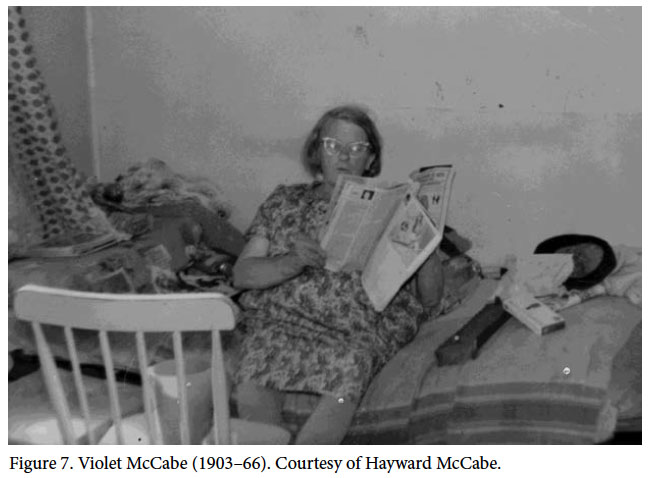Articles
“Took some photos. Everyone seems sorry I am going”:
A New Consideration of Maud Karpeles’s 1929–1930 Newfoundland Folksong Fieldwork
OVERVIEW
1 In 1929 and 1930, the British folksong and dance collector, Maud Karpeles (1885–1976), journeyed to Newfoundland with the express aim of recording British folksongs in Britain’s oldest colony, thus completing an unfulfilled ambition of her mentor and colleague Cecil Sharp, who passed away in 1924. Karpeles’s field research has been well chronicled by researchers (Atkinson, 2001; Carpenter [Henderson], 1980; Emerson, 1937; Gregory, 2000, 2003, 2008, 2008–09; Lovelace, 2004; Narváez, 1995; Peere, 1985). Her diaries of her Newfoundland experiences have been of interest to scholars, offering a “colourful,” first-hand account of her experiences with respect to singers, songs, travel, food,and living conditions. Given the current body of research, one might ask, is there anything more to be said?
2 In 2010, I learned that Karpeles had brought a camera with her and that 41 of these images had been preserved in a photograph album.1 The Vaughan Williams Memorial Library at Cecil Sharp House in London had acquired the collection as part of the estate of her nephew Peter Kennedy (1922–2006).2 Karpeles’s use of a camera while in Newfoundland is a new revelation, adding an entirely different dimension to her fieldwork. For the first time the photographs place Karpeles behind the lens “in the field,” seeing people work the fishing stages, visiting tiny coastal communities, travelling on the coastal boats, and meeting with singers and their families in Newfoundland as it was in 1929 and 1930 (Figure 1).3
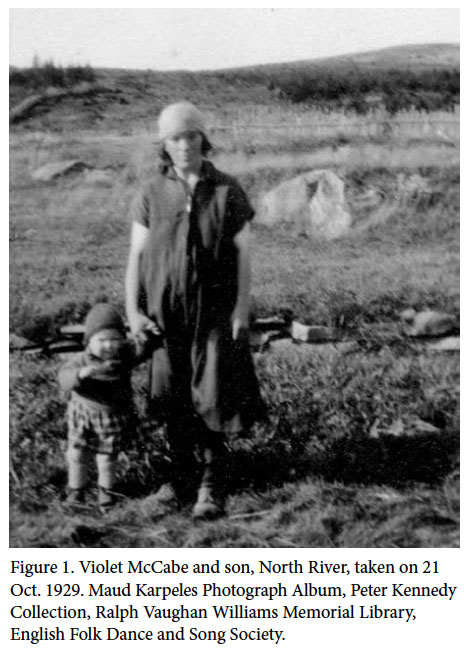 Display large image of Figure 1
Display large image of Figure 13 In this new consideration of her work, linking her photograph album to other field data such as her diaries, music notebooks, and song index, I focus on the singers and communities she visited. Other details secured from presentday family members provide clarification on the social networks she employed to collect songs, but also on the impact of her activities. Their contributions give additional relevance to her work, enabling us to reconsider the totality of her Newfoundland field experience, not just segments and sections.
KARPELES’S NEWFOUNDLAND FIELD RESEARCH — A TIME LINE
4 In 1929, Karpeles was invited to direct a folk music school at Massachusetts Agricultural College (which would soon become the University of Massachusetts) in Amherst, Massachusetts. As the school was scheduled for late August, she seized the opportunity to visit Newfoundland with the express aim of collecting folksongs in Britain’s oldest colony. A proponent of the English folksong revival movement, she had already spent 48 weeks between 1916 and 1918 in the southern Appalachians with her colleague and mentor Cecil Sharp (1859–1924) (Figure 2) collecting over 1,700 songs (Sharp, 1932).
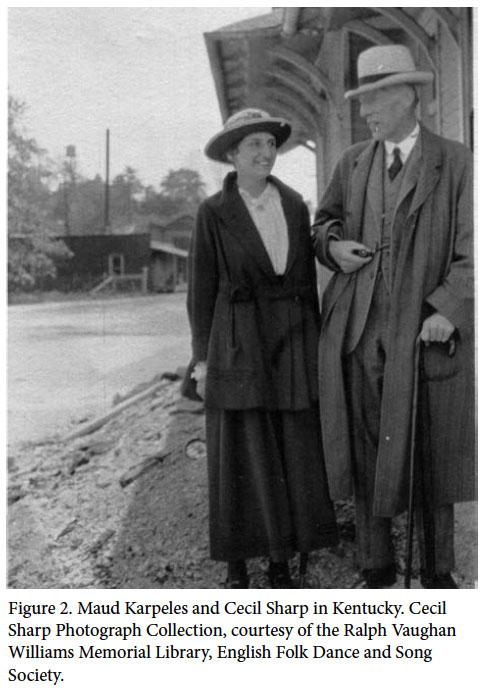 Display large image of Figure 2
Display large image of Figure 25 As early as 1917, Sharp had expressed an interest in coming to Newfoundland. In June of that year, while in Boston, he happened to interview a maid from Harbour Grace who was “no singer” but provided him “interesting information” on the country.4 Sharp and Karpeles entertained the idea of going, but it proved impractical. They again attempted to go the following year, even exploring the possibility of securing passports. Reluctantly, in early July, Sharp recognized that for the sake of economy they would have to give up the project.5 Plans to make another attempt were thwarted by Sharp’s untimely death in 1924, so Karpeles decided to undertake the journey herself.
6 Certainly some of the St. John’s elite were aware of Sharp’s efforts to collect and revive folksong and folk dance, partly because of information coming to the island via local newspapers. In July 1917, the Evening Telegram reported that Jubilee scholar Miss Eleanor Mews (1895–1996) had just returned to St. John’s following three years of courses at the University of Toronto. Part of her instruction included “Folksongs and Folk Dancing under Mr. Cecil Sharp.”6 While in North America between 1915 and 1916, Sharp visited Canada at least twice. In April 1915, he spent a brief period in Montreal as part of a lecture tour. In November 1916, he and Karpeles also spent close to two weeks in Toronto giving classes and folk dance lessons at the University of Toronto and at the Margaret Eaton School of Literature and Expression on Bloor Street.7
7 Karpeles arrived in Montreal on 20 July 1929 and for the next several weeks she spent time in Ontario and Vermont collecting both songs and dances before heading to the summer school at Massachusetts Agricultural College (Pakenham, 2011; Gregory, 2003). In early September, after fulfilling her commitments to the summer school, she departed for Halifax, Nova Scotia, where she boarded a steamer for Newfoundland. Although Gregory offers a detailed chronology of Karpeles’s Newfoundland explorations (2008, 2008–09), a brief review will provide a context for this current appraisal of her field research.
KARPELES’S NEWFOUNDLAND TRAVELS
8 On 9 September, Karpeles arrived in St. John’s harbour with one printed travel guide and two letters of introduction: one to lawyer Frederick Rennie Emerson (1892–1972) and another to John Lewis Paton (1863–1946), the President of Memorial College (Packenham, 2011: 175; Guigné, 2008: 56–58).8 Since at least the early 1920s both men had been admirers of Cecil Sharp’s work and that of other British romantic nationalists who were interested in the documentation and revival of British folk dance and song (Paton, 1925, 1934: 405; Emerson, 1937). They therefore welcomed her investigations into Newfoundland traditional song and dance.
9 Paton evidently made enquiries on her behalf for he had received a note from Church of England organist and choirmaster R.T. Bevan listing the names of four clergy — Rev. James Rees, Bonne Bay, Rev. Rowe, Catalina, Rev. Brown, Exploits, Rev. Ross, Bonavista — who had been identified as “musical men who may be useful in connection with the Folk Dance collecting” (Paton Collection; Colton, 2014: 92). Paton no doubt passed the information to her when they met on 10 September, the day after her arrival. Emerson immediately befriended Karpeles and, over the course of her work, extended his hospitality and facilitated her field excursions. Karpeles’s arrival also drew the attention of P.K. Devine (1859–1950), a local historian and journalist who had written on many aspects of Newfoundland culture and history.9 Like Paton and Emerson, Devine was aware of the British and American folklore and folksong movements.
10 Devine and Karpeles met at the hotel lounge where she was staying and undoubtedly he informed her on opportunities for collecting. In her diary she noted, “I took down tune of Cushion Dance from him, much to the amusement of bell boys as he tramped around whilst singing it, finally kneeling down in front of me presenting me with the cushion i.e. my newspaper.”10
11 That same day Karpeles met with Devine’s nephew Gerald S. Doyle (1892– 1956), a manufacturer’s agent whose business connections extended across the island and Labrador. A native of King’s Cove, with a passion for Newfoundland music and culture, Doyle first started publishing locally composed folksongs from such sources as John Burke (1851–1930), James Murphy (1868– 1931), and Daniel J. Carroll (1865–1941) in his freely distributed newspaper, The Family Fireside (Guigné, 2008: ix). In 1927, Doyle expanded on these activities, releasing Old-Time Songs of Newfoundland, a compilation of indigenous song texts acquired mainly from these and other St. John’s balladeers (Story, 1971). This publication was the first of what would eventually become five Doyle songbooks (1927, 1940, 1955, 1966, and 1978). As Doyle distributed it free of charge to his customers, many of the songs in these publications became highly popular, eventually helping to shape the Newfoundland folksong canon (Rosenberg, 1991, 1994).
12 In her quest for songs and ballads of British origin Karpeles was not likely to be interested in the kind of songs that Doyle had compiled, as these were of the local “Come All Ye” variety. Most collectors at that time, such as Karpeles, selected according to an elitist antiquarian ethic in which the rare and least available “traditional” British ballads compiled by Harvard professor Francis James Child (the Child ballads) were most sought and treasured, more recent broadside ballads and songs of British origin came next, and the more nearly contemporary songs of the living folk about local events and activities were least valued. Nevertheless, she noted, he offered her “valuable information ab[ou]t the country.”
13 On 12 September, Karpeles set out on the Newfoundland Express train to start her field research. Shortly after her arrival in Trinity East she learned that the American Grenfell Mission teacher Elisabeth Bristol Greenleaf (1895– 1980), along with Grace Mansfield (1907–1981), had already been to Newfoundland during that summer collecting folksongs.11 Although Karpeles would not have known the details at the time, Greenleaf had previously spent the summers of 1920 and 1921 on the Great Northern Peninsula working as a teacher for the Grenfell Mission (Rompkey, 1991). It was here that she got her first exposure to the Newfoundland song tradition, documenting several songs from these visits. Greenleaf (1928) subsequently secured a grant from Vassar College to document folksongs in a more extensive manner.
14 Although caught off guard by the activities of the American women, Karpeles forged ahead, spending the next seven weeks travelling by rail, car, rowboat, and on foot visiting various communities, mainly on the Avalon Peninsula and the northeast coast. Starting in Bonavisita Bay she met and collected songs from residents in West Champneys, Stock Cove, King’s Cove, and Open Hall. Taking the train to Clarenville, during a brief stopover she acquired a couple of songs from singers in Milton, before travelling west to Exploits and Fortune Harbour. There she notated a number of songs from some of the same singers Greenleaf and Mansfield (1933: 22) had earlier visited.
15 Returning to the Avalon Peninsula, Karpeles rounded out her fieldwork taking down songs from singers in Harbour Grace, North River, Upper Island Cove, Avondale, Colliers, Kitchuses, Conception Harbour, Chapel Cove, and Lakeview-Harbour Main. That first summer she noted by hand 112 songs and tunes and several dances.12 At Dr. Paton’s request, prior to her departure, on 29 October, Karpeles gave a lecture on her findings to 200 students at Memorial College.13
16 Before going back to Britain, Karpeles returned to Halifax to join her colleagues in the English Folk Dance Society, 14 of whom had been invited to carry out demonstrations of Morris Dance throughout Canada and the United States (“The Tour,” 1930; Stone, 2007). Sponsored by the National Council of Education and the Canadian Pacific Railway, the tour extended all the way to Canada’s west coast. It provided Karpeles with an opportunity to collect folksongs in Regina and Vancouver, thus adding new material to her modest Canadian collection.
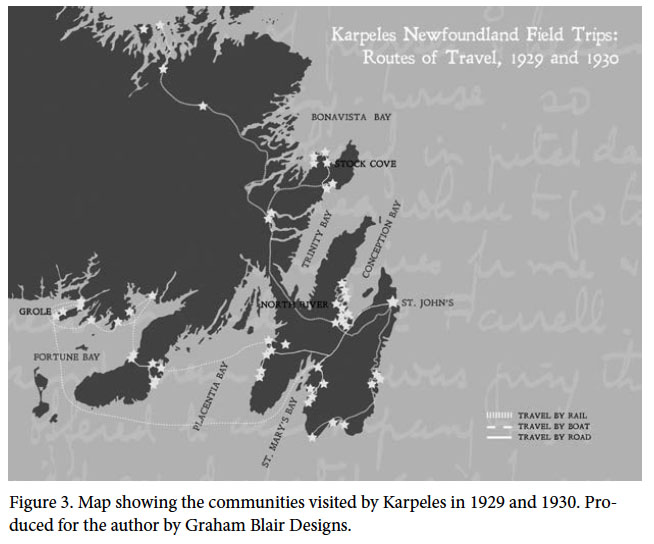 Display large image of Figure 3
Display large image of Figure 317 Karpeles revisited Newfoundland in June of the following year to expand on her field research, this time concentrating her folksong investigations in Placentia Bay, Fortune Bay, and along the south coast. Once again she saw Gerald S. Doyle, who kindly provided her with letters of reference to various people in the outports who could help her find accommodation.14
18 On 4 July 1930, Frederick Emerson’s wife Isabel and friends drove Karpeles to Placentia and from there she initiated her research. Over five days she acquired a small number of songs from singers in Placentia, Dunville, Gooseberry Cove, and Ship Cove on the Cape Shore. Karpeles then boarded the S.S. Glencoe coastal ferry for the Burin Peninsula, visiting Marystown, Burin, Beaubois, and Frenchman’s Cove. Via Garnish, she headed for Belleoram by open boat and for the next several days worked her way along the south coast, locating singers in Frenchman’s Cove, St. Jacques, Rencontre, Hermitage, Gaultois, Grole, and Pass Island. On 24 July Karpeles took a coastal steamer to St. Mary’s Bay, collecting songs at River Head, Gaskiers, and Point La Haye. On 30 July she returned briefly to St. John’s. The next day, to round out the season, she caught the train to Calvert on the Southern Shore, visiting the communities of Ferryland, Trepassey, St. Shott’s, Portugal Cove South, and Fermeuse. On 6 August, in Ferryland, Karpeles collected her last song, “The Blind Beggar’s Daughter,” from Mrs. James Walsh (1971: 190).15 By the end of this second field season she had acquired 89 texts and tunes. Concluding her work in early August, Karpeles returned to Amherst, Massachusetts, teaching again at the summer school before landing back in England in the fall.
19 Between 1929 and 1930, over a combined total of 14 weeks of field research in Newfoundland, Karpeles managed to visit 41 communities (Figure 3), notating 201 songs and a small number of dances (Guigné, 2012) from approximately 104 singers.
KARPELES DISSEMINATES HER NEWFOUNDLAND RESEARCH
20 In the initial years following her Newfoundland fieldwork, Karpeles publicized her findings through various lectures and publications. On 30 October 1930, in London, she discussed her Newfoundland folksong expeditions in a lecture sponsored by the English Folk Dance Society.16 Material she had collected while in North America also appeared in various articles by her and others. Shortly after her return, Karpeles published some dance material she had acquired in the United States and Ontario (1930, 1931a). In conjunction with the British song collector Anne G. Gilchrist (1863–1954) and A. Martin Freeman (1878–1959), she also published six songs she had acquired in Canada in the Journal of the Folk-Song Society (1930). Gilchrist also used three Newfoundland versions of “Sir James the Rose” (Roud17 2274) that Karpeles had collected for an article on Scottish songs (1936: 58–59). Karpeles also published two of the Newfoundland dance tunes she had documented, “The Self” and “Kitty’s Rambles,” in her 1931 collection Twelve Traditional Country Dances (16–17 and 31–32). “The Cushion Dance” (Roud 19195), which she had acquired from P.K. Devine, was included as one of “Five Folk Songs” in the 1937 Journal of the English Folk Dance and Song Society (133–34).
21 Most notable for this period is Karpeles’s 1934 publication, Folk Songs from Newfoundland, consisting of 30 songs with arrangements for solo voice and piano, dedicated to Frederick R. Emerson, who had befriended her while in Newfoundland. Fifteen of the song arrangements were by her close friend Ralph Vaughan Williams (1872–1958), with additional contributions by Clive Carey (1883–1968) and Hubert Foss (1899–1953). As all of these composers were passionately involved with the revival of British folksong, concepts of British romantic nationalism considerably shaped their approach to folksong documentation and arrangement (Colton, 2009). That same year Karpeles also released a separate edition Fifteen Folk Songs from Newfoundland (1934b); all of the arrangements were by Vaughan Williams and had previously been included in Folk Songs from Newfoundland.
22 The Newfoundland material Karpeles published in these early years represented just a small segment of her entire field collection. By this time, though, she had turned her attention to other activities, including preparations for a huge international festival to be held in London in 1935, organized by the EFDSS (Packenham, 2011: 199).18 She also took it upon herself to edit Cecil Sharp’s massive, two-volume Appalachian collection (Sharp, 1932). By comparison, when Elisabeth Greenleaf and Grace Mansfield released Ballads and Sea Songs of Newfoundland (1933) the publication included about 200 texts with music.
23 Karpeles later reviewed Greenleaf’s book (1933: 105-06) and it likely caused her to reflect on the amount of material she had yet to publish. In her assessment, her own bias towards “authenticity” (i.e., British provenance, antiquity, and anonymity) stood out. She noted that the collection “contained many popular songs which are not folk-songs.” Undoubtedly, her collecting agenda differed greatly from that of Greenleaf and Mansfield in that the newness of some material did not fit with her perceptions of a true “folk-song.” On the other hand, as she also appreciated, singers “recognized no distinction” but drew upon songs from many different sources. In considering the diversity of material in the collection Karpeles conceded that categorizing songs into “folk” and “non-folk” was not easy because so many songs were “borderline.” The lyrics were wedded to an old tune, or cast in the “folk-idiom,” or “composed on a folk-basis,” and as she pointed out, “this collection contains examples of all these,” including many about local events of one form or another.
24 Although the broadness of the collection was less appealing to her, she was impressed with the “genuine folk-songs,” which were mainly from the British Isles. She noted, for example, that of the 19 Child ballads in the collection, “Earl Brand” (Roud 23), “Hind Horn” (Roud 28), and “Babylon” (Roud 27) were rarely found in England. As so few publications of Anglo-American folksong existed at this time, Karpeles probably was impressed with the material acquired by the Americans. Years later, when publishing the remainder of her collection, Ballads and Sea Songs would be one of several valuable resources she consulted (1970: 293).
WOMEN ADVENTURERS, NEWFOUNDLAND, AND CANADIAN FOLKSONG SCHOLARSHIP
25 The folksong collecting activities carried out by Karpeles, and by Greenleaf and Mansfield, went well beyond the early twentieth-century songsters assembled by Gerald S. Doyle, John Burke, and James Murphy, whose works emphasized a strong patriotic interest in local song material.19 The explorations of these women subsequently shifted the “mainly urban” perceptions of Newfoundland folk music by highlighting the diversity of traditional song material in the country. As arrangements of Newfoundland folk music were almost non-existent, Karpeles’s publication also gave much credibility to the business of folksong collecting. At the same time it assigned an artistic value to Newfoundland folksongs.
26 In the first comprehensive article on “Newfoundland Folk Music,” Frederick R. Emerson highlighted the pioneering research by these women adventurers by noting their works “reveal that the fisher-folk of Newfoundland have inherited a wealth of music of which they may be proud and have musical gifts of a very interesting quality” (1937: 234). In subsequent years when lecturing to students at Memorial College, Emerson often drew upon Karpeles’s research to illuminate his talks, thereby making Newfoundland students aware of their distinct folk music heritage (Guigné, 2008: 58).
27 This new outside interest in the documentation of Newfoundland folksong, created by women, also shaped future explorations of Newfoundland and Labrador folksong in years to come. In the case of the documentation of British folksong traditions, these publications also provided “the earliest reports of Child ballads sung in Newfoundland” (Quigley, 1980: 17).
28 Extending beyond Newfoundland, in the period following World War II, as Canadians sought to reify their identity as a new emergent nation, folk music was equated with national heritage. This led to an interest in folksong research and publication. Within this milieu, the publications created by Karpeles and by Greenleaf and Mansfield provided source material for Edith Fowke and Richard Johnston’s Folksongs of Canada (1954). The activities carried out by these women also inspired Margaret Sargent to conduct six weeks of folksong investigations in St. John’s, Branch, and St. Bride’s in 1950 on behalf of the National Museum of Canada (Guigné, 2007).
29 The classical composer Kenneth Peacock (1922–2000), who eventually took over from Sargent, acquiring close to 800 songs from six major field trips in Newfoundland between 1951 and 1961, was also influenced by these early publications. Although he observed in Songs of the Newfoundland Outports (1965, vol. 1: xxi) that previous research tended to be “rather limited and haphazard,” such works provided direction in terms of source material and informants. During his field investigations Peacock contacted several singers previously visited by Karpeles and by Greenleaf and Mansfield, collecting additional material from them (Guigné, 2008: 55, 58).20
30 The explorations carried out by Karpeles and Greenleaf and Mansfield also prompted the American scholar MacEdward Leach (1892–1967) to visit Newfoundland. Leach saw the island as a potential research area mainly because of the folksong work carried out in the eastern United States and through his personal research in eastern Canada, including Cape Breton, in the late 1940s. The publications created by these women reaffirmed for him that Newfoundland was an important area for collecting (Guigné, 2004: 121–22). Leach subsequently spent two field seasons in 1950 and 1951 collecting folksongs on Newfoundland’s west coast and on the Avalon Peninsula.21
31 In the late 1950s, with the encouragement of her friend and colleague, the Canadian folklorist Marius Barbeau (1883–1969), formerly of the National Museum of Canada, and with much encouragement from Frederick R. Emerson, Karpeles began publishing the remainder of her Newfoundland folksong collection. Barbeau and Emerson levered a $5,000 grant from the newly established Canada Council to assist her (Guigné, 2004: 377). In 1970, Karpeles subsequently released a new edition of Folk Songs from Newfoundland consisting of 89 song titles with variants and a small number of dance tunes. That year Karpeles returned to Newfoundland briefly to receive an honorary degree from Memorial University in recognition of her folksong work. Following her death in 1976, as per the instructions in her will, Karpeles’s Newfoundland collection — music field notebooks, music score books, shorthand notebooks, a tune and text index, some letters, and two diaries — was bequeathed to Memorial’s Folklore and Language Archive (MUNFLA).22
DISCORDANCE AND DEBATES PERTAINING TO KARPELES’S NEWFOUNDLAND FIELD RESEARCH
32 Since the 1970s, researchers have taken an interest in studying the lives of their predecessors so as to evaluate the ideologies guiding their investigations (Carpenter, 1980: 111). So it is that current considerations of Karpeles’s Newfoundland work have drawn extensively on this archival collection. Typical for the time period, Karpeles provides few contextual details regarding the singers she encountered, instead confining her observations to her two diaries and letters to family and friends. This is not unusual: in this pioneering stage of song collecting, the song often took precedence.
33 As Lovelace points out, the diaries are not “true field notes” (2004: 284) because of the lack of ethnographic detail; but they do offer an opportunity to see “cultural selection taking place.” Her opinions on song greatly reflected those of the English Folk Dance and Folk Song Society circles back in Britain. Her diaries have been of particular interest to scholars mainly because of Karpeles’s frank observations with respect to the challenges of travel, quality of food, flies, and living conditions in the outports and the difficulties of finding the appropriate kinds of songs.
34 Over the years, Karpeles’s comments have caused considerable controversy and discordance among scholars. Carpenter (1980: 117) sees her as paternalistic and colonialist, while Lovelace (2004: 284) argues that Karpeles had a limited agenda and therefore no interest in locally composed song. Nárvaez observes that she was “extensively influenced by conservative ideological biases about the ‘folk’ and ‘folksongs’” (1995: 215). Peere, who contrasts her approach with that of Elizabeth Bristol Greenleaf — whose folksong fieldwork work overlaps with Karpeles’s — found the latter’s diary a “bitter report” (1985: 26) in comparison with Greenleaf’s “sweet memories of their stay.” Peere also found Karpeles to have “a rather possessive interest in the songs at the expense of the singers” (ibid., 25).
35 As Posen observes, since both women collected songs in Newfoundland within weeks of one another, Karpeles has inevitably been “doomed to stand” in Greenleaf’s shadow (2012: 133). Scholars do Karpeles an injustice with such comparisons because she and Greenleaf were different individuals. Karpeles’s perspective was shaped by her personal quest and song-collecting paradigm (ibid.). Greenleaf also had an advantage over Karpeles in that prior to carrying out her 1929 “Folklore Expedition” (1928: 23) with Grace Mansfield, through her work for the Grenfell Mission she was well informed about the difficulties of travel and outport life. Unlike Karpeles, who was forced to move from community to community on her own, much like a stranger in a strange land, Greenleaf had Mansfield as a travel companion and they were able to tap into the Grenfell networks for travel and accommodation (Rosenberg and Guigné, 2004).
36 Current appraisals of her collecting approach certainly are justified. She was not interested in any song material unless it was of British origin. Unquestionably, Sharp’s pre-eminent notions on the theory and performance of folk dance and song influenced Karpeles (Atkinson, 2001: 92). However, her achievements are often overshadowed by Sharp’s activities. Although she often is depicted as his amanuensis or assistant, based on the letters from Sharp to Karpeles he was highly reliant on her (ibid., 93). Between 1916 and 1918, she also accumulated substantial field experience while working in the Appalachians with Sharp. During this period they acquired “versions of some five hundred different ballads and songs from 281 traditional singers” (ibid., 90).
37 Regardless of the theories underpinning her Newfoundland research, many researchers looking at Karpeles’s materials for this period have yet to take into consideration the totality of her work as well as the many challenges that she faced along the way. In his consideration of her Newfoundland journeys Gregory (2000: 154–55) argues that several of the comments about Karpeles are “misleading.” Instead, he points out, Karpeles was more “cosmopolitan” than “ethnocentric” and she “needed a lot of courage” to make the journey alone as a woman. Karpeles’s remarks about her Newfoundland experiences also hold much credence, particularly because of her experiences during three previous field expeditions in the Appalachians. As her diaries and those of Cecil Sharp reveal, the fieldwork they carried out was very demanding and strenuous. She and Sharp suffered through many illnesses, dental issues, heat, dirt, poor hotels, and inedible food (Atkinson, 2001: 93; Yates, 2004: 3–27).
38 The current discordance among researchers with respect to Karpeles’s Newfoundland fieldwork is understandable because the focus of attention has been almost exclusively on her diaries and letters. Simona Packenham’s recent biography, Singing and Dancing Wherever She Goes (2011), based primarily on Karpeles’s unpublished autobiography, does devote space to the Newfoundland fieldwork. Appreciably, as the information is fitted in alongside other aspects of Karpeles’s activities over several decades, the details are really an overview of her investigations.
39 Packenham’s account does contain new information in that it includes a selection of photographs from Karpeles’s Newfoundland Album (Packenham, 2011: 98, 122–23, 127, 172, 175–79, 190–93, 248–49, 257). Karpeles probably took a camera with her because it had been customary for Sharp to document the people and places he had visited while in the Appalachians. However, she appears to have taken the images more as points of interest than for research purposes.
RECONSIDERING KARPELES’S NEWFOUNDLAND FIELD COLLECTION
40 Although Karpeles’s diaries are an important resource, researchers have tended to print extracts in isolation, creating a certain bias about her fieldwork approach, her treatment of singers, and her opinions of the living conditions she experienced in Newfoundland. Moreover, with few exceptions (e.g., Carpenter, 1980), scholars have shown little interest in making contact with any of the singers and/or their families to learn more about the material she acquired.
41 As I have found even eight decades later, there is still a window of opportunity to breathe new life into these publications by engaging both the collectors themselves and/or singers who are still alive to talk about their musical traditions. In instances where singers have passed on, contact with family members can be equally rewarding because of the personal reminiscences they bring to bear on the singers and their songs (Guigné, 2004, 2007).
42 With this in mind, using the Newfoundland photographs as a departure point, I revisited Karpeles’s field collection to learn more about her travels and about her field research. As a first thrust I began by transcribing and annotating her diaries in their entirety so that her Newfoundland experiences could be read in a continuous manner. To obtain a more balanced reading of Karpeles’s Newfoundland fieldwork, I generated various inventories to account for the total number of singers, communities, and songs in her notebooks. These were paired with her music field notebooks, her music notation books, her text and music index, her binder of typed lyrics, and her diaries to create a more complete picture of her field research.23
43 Internet searches of community Facebook pages and Newfoundland genealogy websites combined with numerous phone calls provided a means of tracking down information on singers. The result of this new avenue of exploration is an ever-increasing database of information ranging from singers’ birth and death dates to details on family singing traditions, singers’ musical talents, occupations, and community heritage. Although a full account of these findings would require a longer narrative, what follows is a sampling of the information about the people and communities she visited that I unearthed by these methods.
Stock Cove, Bonavista Bay — 18–22 Sept. 1929
44 On 18 September 1929, Karpeles visited the tiny community of Stock Cove, Bonavista Bay. Most of its 95 Catholic residents made their living farming and fishing, supplemented by logging. In the off-season many residents migrated to the United States for work (“Stock Cove,” 1994: 309–10). This was a profitable area for Karpeles. Over the course of a week, in between collecting songs in nearby King’s Cove, she acquired 12 songs from the residents of Stock Cove, including four from the Heaney–Mahoney family.
45 Brenda Haley notes that her grandfather James Heaney (1887–1962) (Figure 4) was originally from Plate Cove.24 His father John and his mother Margaret Whelan Heaney married in August 1883. She died when James was quite young and, as his father John was not able to make a living and care for the children, they were placed with family and friends. James went to live with the Walsh family in Stock Cove.
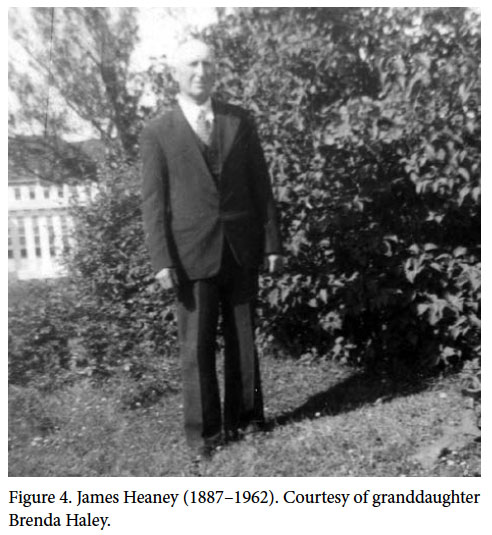 Display large image of Figure 4
Display large image of Figure 446 James occasionally went with his brother Clem (b. 1891) to Boston to work in the construction industry because money was scarce. He and his brother lived there with friends of the family from Plate Cove and King’s Cove who were also going back and forth. Once he married Lucy Mahoney (1895– 1979) (Figure 5), the daughter of John and Mary Mahoney, also of Stock Cove, he stayed home.
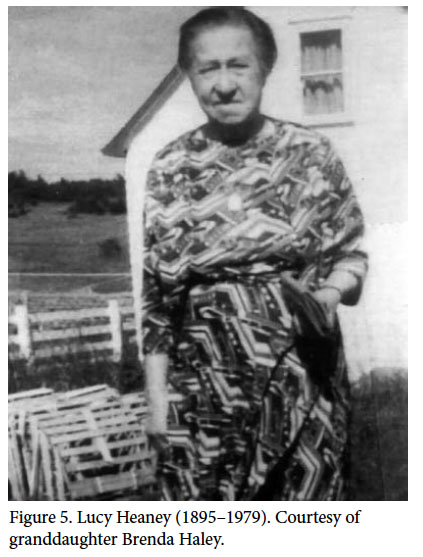 Display large image of Figure 5
Display large image of Figure 547 James was very musical; he played the accordion and sang. According to Hilda Heaney Nugent, her mother also loved a good song: “I know she used to be always singing, Mom, morning, noon, and night. She was always singing. A lot of the old Irish songs: ‘Silver Threads Around the Gold’ [Roud 6403] and Kathleen, that one about Kathleen . . . .”25 James and Lucy also had an organ in the house, which was unusual for the time. As Brenda Haley points out, “The organ was especially popular because people who could play were often called upon to play for church services,” such as at the Catholic Church in King’s Cove.26
48 Lucy’s family on the Mahoney side also enjoyed singing. Old Mrs. Mahoney, age 96, provided Karpeles with “Pretty Sally” (Roud 180) (Karpeles, 1970: 109–10). Lucy’s brother John and his wife Lizzy (a Lee originally from Riverhead, St. Mary’s Bay) had a large family. As Brenda notes, they were “all into music.” Lizzie Mahoney sang two songs for Karpeles; an unpublished version of “The Rich Merchant’s Daughter” (Roud 2301) and “Rose of Britain’s Isle” (Roud 1796) (1970: 173–75).27
49 Karpeles evidently discussed dance traditions with the family as James Heaney organized a gathering for her at his home. She noted in her diary: “Got back to King’s Cove ab[ou]t 6 & then after tea motored back to Stock Cove for a dance given by Mr. Heaney . . . . I sang and taught them a figure of R. Set much to their delight. Got back ab[ou]t 1 a.m.”28 In a letter to her sister Helen Kennedy she noted: “I saw a dance at Stock Cove on my second evening, got up in a private house for my benefit. They did ‘Sets’, Reels and the Kissing Dance. The Sets are composed of Quadrille figures with a great deal of swinging partners, and not interesting except for the ‘stepping’ which is very characteristic.”29
50 Colin Quigley, who carried out the first extensive study of Newfoundland traditional dance and dance events, points out that accounts of traditional dance in this region are fragmentary (1981: 31). In this regard, Greenleaf and Mansfield did note down several dance tunes during their expedition (1933: 376–81). Karpeles, however, had the background and expertise to notate the accompanying folk dance steps along with the tunes. We are fortunate to have this material in her field collection. As Quigley comments, Karpeles “did not restrict her note taking quite so severely as her publications, and these give a more representative picture of the dancing she saw” (1981: 33).
51 Karpeles’s visit and the house dance James Heaney arranged for her was a significant community event; weeks later, in a news item called “Stock Cove,” the following account was reported in the October edition of Gerald S. Doyle’s Family Fireside:
52 The Heaneys and Mahoneys evidently had a vast repertoire. When Kenneth Peacock visited the Stock Cove area in 1952, 28 of the songs he acquired in this locality came from this family network. This includes 16 from James and Lucy Heaney. Peacock later published much of this material in Songs of the Newfoundland Outports (1965).
North River, Conception Bay — 15–21 October 1929
53 A reading of the various data in Karpeles’s field collection reveals that she regularly tapped into family networks to acquire songs. A case in point is the material she notated in North River, a small fishing and agricultural community southwest of Clarke’s Beach, Conception Bay (ENL 4, 1993: 107–08). In October 1929, while staying at Yetman’s Hotel in Harbour Grace, Karpeles recorded in her diary that the proprietress, “Brought in the servant girl whilst I was having dinner and commanded her to sing to me, wh[ich] the latter did!”30 This was most likely Zeala McCabe (b. 1911), who sang “Sweet William’s Ghost” (Roud 50) for her (Karpeles, 1970: 54). On Zeala’s advice Karpeles subsequently visited her older brothers John and James in the community of North River about 20 miles away.
54 North River proved to be a rich area; over the course of six days Karpeles notated 36 songs, including those from John and James McCabe and from sisters-in-law Violet and May McCabe, the wives of the brothers. She remarked in her diary:
Shortly before her departure a week later Karpeles noted, “Paid my farewell visit to North River getting a couple more songs. Took some photos. Everyone seems sorry I am going....”32 She later identified the images in her photograph album as being those of John and Violet McCabe (Figure 6).
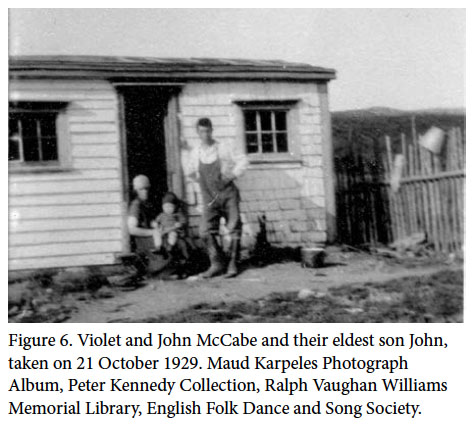 Display large image of Figure 6
Display large image of Figure 655 In 2011, I located Violet’s youngest son, Hayward McCabe, who was surprised and moved to learn that there was such a record of his mother’s singing, which he fondly remembers. After receiving copies of Karpeles’s photographs, McCabe noted in a letter that the young boy next to his mother (Figure. 6) was his oldest brother John (b. 1928), now deceased.33 He also informed me that Emma Boone, from whom Karpeles collected version B (1970: 54) of “Sweet William’s Ghost” (Roud 50), was originally a Snow and also John and James McCabe’s grandmother.
56 Five of the 36 songs she collected in North River also originated with Hayward’s mother, Violet McCabe. In reminiscing about his mother (Figure 7), Hayward McCabe noted that she was an avid reader and she also loved to sing. Violet was originally a Pye from Carbonear.
57 When her father died at Vimy Ridge in World War I, her mother was forced to send her to the Anglican orphanage in St. John’s. Mr. McCabe feels that perhaps this is where she learned her songs. Although Mr. McCabe recalled his mother’s singing, until recently he was unaware of her connection to Karpeles. He was pleased to share his memories and to see his mother’s images from long ago. As he later remarked, “In reply to your package of material of songs that my mother [sang] for Mrs. Karpeles and photos of my mother, father and brother John was something I never thought in my wildest dreams I would see, and I am very thankful to you for that.”34
58 In 1970, when Karpeles returned to Newfoundland to receive an honorary doctorate from Memorial University, she revisited North River, Conception Bay (Carpenter, 1980), accompanied by Dr. Herbert Halpert (1911–2000), then head of Memorial’s Folklore Department, and folklorist Carol Carpenter, only to discover that many of her contacts had since passed away, including Violet McCabe. She did meet with Mrs. [James] Hall (formerly Florrie Snow), who had given her “The Bonny Banks of Virgie-O” (Roud 27) (Karpeles, 1970: 28), and she visited Mrs. Edward (Rose) Snow, who she recalled singing “The Cruel Mother” (Roud 9) (ibid., 113).35 Carpenter notes that, much to Karpeles’s frustration, Mrs. Snow had no recollection of singing the song for her.
59 When scrutinizing Karpeles’s music notebook I discovered that there had evidently been a mix-up; she had actually recorded the song from Mrs. G.J. (Rose) Snow and it was one of several examples that she chose not to publish.36 As this was some 40 years later, Karpeles had confused the two singers. The visit by Karpeles, Halpert, and Carpenter was one of the rare instances any attempt had been made to reconnect with singers and their families.
FAMILY AND COMMUNITY INVOLVEMENT — THE MISSING COMPONENT
60 In some cases the information acquired through my investigations admittedly has been fragmentary. Acquisition of even these details helps to fill in gaps in Karpeles’s collection.
61 For example, between 10 and 11 October 1929, Karpeles visited Upper Island Cove, taking down songs from Fred Mercer (who she noted was blind), and from Aunt Selina Coombs (age 90) and Aunt Sally (Sarah) Mercer (age 70). In the fall of 2012, I sent an e-mail to Randall Mercer, the administrator of the website “Upper Island Family Roots” asking if he knew anything about these singers. In late December he replied, “Re the individuals that you are inquiring about: 1. Fred Mercer — he was indeed blind, and died in 1934 in his late 70s. 2. Selina Coombs (1842–1936). 3. Sarah Jane Mercer (1858–1944).”37
62 Similarly, between 23 and 25 October 1929, Karpeles visited Conception Harbour, staying with Mrs. Lewis, “who has a biggish house.” Here she noted down songs from Mrs. Curran and Teresa Corbett. Retired teacher Helen Keating, a long-time resident of the community whose parents frequently had house parties, informed me in 2012 that Mrs. Lewis was Bridget Lewis or “Aunt” Biddy Lewis. She remembered Mrs. Curran and could “visualize her performing ‘Sweet Forget Me Not.’” She also recalled Teresa Corbett, but noted that the family had since moved to the United States: “All the men went to New York to work as iron workers, dock builders and with the Gloucester Pogie [baitfish] Fishery.”38 Later, in an undated letter to Karpeles, Teresa Corbett would make reference to this migration, noting, “My husband came from New York a week ago after three years away from home and sure he wanted to know were [sic] I meet you [sic] and I told him a why [sic] in London haha and he now wishes to be remembered to you.”39
Placentia — 4–8 July 1930
63 Contact with the community has been essential to this project. Such inquiries have also helped to fill in gaps in Karpeles’s own diary accounts. As a typical example, between 4 and 8 July 1930 she visited Placentia and the Cape Shore on the Avalon Peninsula, notating 10 songs from six people: Michael Carroll, Mrs. Maurice [Jane] Flynn, Agnes Tobin, Mary Ellen Doyle, and John and Patrick Hunt. She also took several pictures of the landscape, but none of the singers.
64 New details about many of these individuals were acquired through the assistance of Anita O’Keefe, the cultural assistant for the Town of Placentia’s Cultural Archives who contacted family members on my behalf. The comments now shared by these relatives offer a more balanced reading of Karpeles’s diary comments.40
65 For example, on 8 July1930, Karpeles made a one-hour boat excursion to Dunville, Placentia, landing up at “Old Jimmie Hunt’s,” where she found the house “filthy, but the people as ev[er]ywhere, most charming and friendly.”41 As Jimmie was “old and childish” the sons “came to the rescue,” giving her three songs: “Gypsie Laddie” (Roud 1) from Patrick Hunt, and “She’s Like the Swallow” (Roud 2306) and “A Man in Love” (Roud 990) from John Hunt (1887–c. 1938).
66 Although Karpeles was particularly taken with “She’s Like the Swallow,” as Lovelace (2004: 294) observes in his reading of her diaries, surprisingly, she said nothing about collecting the song. Upon returning to England, she had her colleague Ralph Vaughan Williams (1872–1958) put the song into an arrangement, which was eventually included in Folksongs from Newfoundland (1934a, I:112; 1934b:31). Typical for the period, John Hunt was acknowledged as the singer, but little further information was given. Frederick Emerson also published the song in his article “Newfoundland Folk Music” (1937, I: 234), in J.R. Smallwood’s new two-volume compendium, The Book of Newfoundland.42 Again Hunt’s name was mentioned as the source. Long before Kenneth Peacock published versions of the song based on his fieldwork with Charlotte Decker of Parsons Pond and Mrs. Wallace Kinslow of Isle aux Morts (1965, III: 711–14), the Hunt rendition appeared in publications by Fowke and Johnston (1954: 140) and Blondahl (1964: 120). It was also widely recorded.43 Today the song is considered to be a cultural icon (Fowke, 1992: 1214; Colton, 2002; Rosenberg, 2007).
The Hunts of Dunville, Placentia Bay
67 Annie (Hunt) Collins and her cousin Florence (Hunt) Thomas, granddaughters of John Hunt, with the help of their uncle Peter (Pat) John Murphy (1922–2015), have been able to fill in a major gap in Karpeles’s collecting experiences at this home.44
68 The Hunt family lived in Herring Bay, more commonly known today as the North East Arm of Dunville. Peter Murphy, the son of Bridget (Bride) Hunt and stepson to John Hunt, informed his nieces that he was at the house the day Karpeles visited. Although Peter was only nine years old at the time, the visit made an impression on him. When Florence read the lyrics for “She’s Like the Swallow” to him, he readily recalled the song and was able to able to sing it. He also remembered that Karpeles had taken down another song about a gypsy. This song was “The Gypsy Laddie,” which Karpeles notated from John’s brother Patrick (Pad) Hunt (Karpeles, 1934a, I: 13–15; 1970: 83–84).
69 Peter Murphy also corroborated Karpeles’s comments about the Hunt family living conditions, giving further insight into her visit. The Hunts resided in a dwelling that had been constructed to accommodate two families that were related. It was Patrick (Pad) Hunt’s house that Karpeles visited. He lived there with his mother and father, James, and the house was indeed unkempt. His brother, John Hunt, actually lived next door with his own family.
70 According to Peter Murphy, his stepfather John could not read music or distinguish notes. He sang and played by ear only. As he informed his niece Florence, John Hunt had to sing the song about the swallow several times over for Ms. Karpeles to record the notes.
71 Annie and Florence both commented that, although their grandfather John was illiterate, he was musically inclined and could play several instruments. He regularly played the four-step accordion and the tin whistle for the “Lancers,” a Newfoundland dance held at the Barn Dances between “The Borrow” and the P-4 housing area in Dunville. They also recalled that anytime he played, people came from all around. Their grandfather also played occasionally at dances in St. John’s.
72 John’s father James Hunt (b. 1842) also was musical. A fisherman by trade, he frequently went to the Grand Banks with his friend Mike Karl, and these times on the boat were occasions for singing. Sometimes, while in Placentia gathering supplies, James Hunt would meet up with Matt Murphy’s wife, also known to be a good singer. As he was locally recognized for his singing talents, it’s likely that this was the reason Karpeles was directed by people in the community to go to see him. Florence Thomas speculates that perhaps her grandfather John could have learned “She’s Like the Swallow” from his father. Both women pointed out that James Hunt was 88 years old when Karpeles visited, and so by this time his memory had faded.45
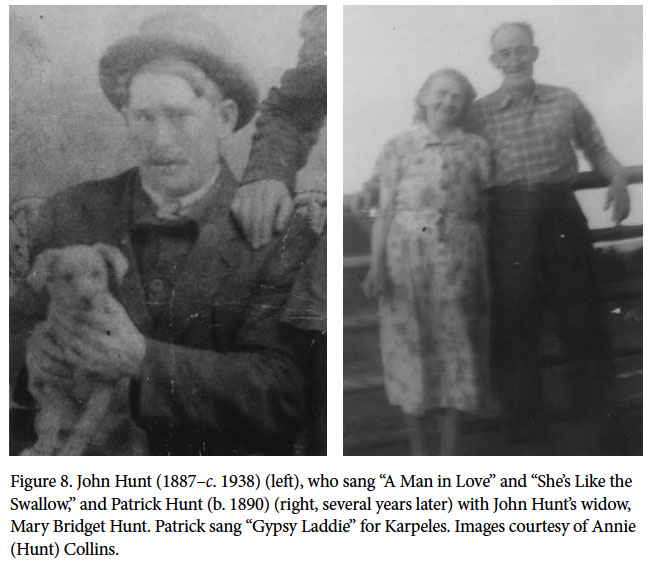 Display large image of Figure 8
Display large image of Figure 873 The family was certainly aware of John Hunt’s contribution to Karpeles’s research. Members of the Hunt family seemed to think that his picture appeared somewhere in a newspaper or something like it, which came from St. John’s. This was perhaps because someone had shown John Hunt the Emerson article in the Smallwood publication, which was highly accessible in Newfoundland.
74 Annie (Hunt) Collins kindly located photographs of John Hunt and of his brother Patrick (Figure 8). Small details such as these help us to re-contextualize Karpeles’s comments. The photographs provided by the family also enable us to connect the songs, including “She’s Like the Swallow,” to the singers in more meaningful ways.
Karpeles’s Day Trip to the Cape Shore — Monday 7 July 1930
75 On 7 July 1930, Karpeles decided to explore the Cape Shore, a stretch of coastline where most of the settlers are of Irish descent.46 Later she commented:
76 At Ship Cove, about 22 kilometres from Placentia, Karpeles met Agnes Tobin, who recited for her the words of “The Sea Captain” (Roud 181) (Karpeles, 1970: 120–21). As there were three Agnes Tobins in Ship Cove at the time, all between 19 and 21 years of age, it took some time to locate the one who had provided Karpeles the song.48 I was connected eventually with Edna Pittman of Point Verde, who confirmed that it was her Aunt Agnes Tobin and that she recognized the song.49 Through a subsequent phone call I came to appreciate how Karpeles had ended up at this particular home.50
77 As Edna explained, at the time of Karpeles’s visit in 1930, a crude road stretched along the Cape Shore. As many people still made their way up and down the coast by foot or by cart, Ship Cove was an important halfway point. The home of John Tobin (1875–1960) and his wife Mary Bridget (née Follett) (1876–1948) was recognized locally as a place to stop over and, occasionally, stay overnight. The family had a stable as well and could offer shelter for a horse and cart. It was likely because of this connection that Karpeles paid a visit to the home. At the time the Tobins had six children, including 19-year-old Agnes.
78 Edna Pittman couldn’t recall anything specific about her aunt’s musical abilities, as she had left home at an early age. When the Great Depression hit, Agnes, then age 20 or 21, moved to New York along with her brother James and sister Christine to find employment, later sending money home to help out. In later years Agnes and her husband Bill Morey, from Flatrock, Newfoundland, whom she met while in New York, did come home for visits, but there wasn’t much time for music as she was seeing several family members in other parts of the province.
79 Edna pointed out that her grandparents were very musical; John played the tin whistle while her grandmother Mary played the accordion. This information was likely conveyed to Karpeles.
The Doyles of Gooseberry Cove
80 After leaving Ship Cove, Karpeles made her way to nearby Gooseberry Cove. Here she paid a visit to Mary Ellen Doyle, who sang her the broadside “Streams of Lovely Nancy” (Roud 688) (Karpeles, 1970: 205–06).
81 According to Florence (Judge) Coffey, James Joe Doyle (1877–1945) was a trapper and fisherman. He and his wife Mary Ellen (1881–1949) were excellent singers with sizable repertoires and they were well known along the Cape Shore and Placentia for their music.51 At a young age Mary Ellen’s niece, Bride McGrath Judge (Florence’s mother) of nearby Patrick’s Cove, moved in with her aunt and uncle to care for them (Figure 9).
 Display large image of Figure 9
Display large image of Figure 982 Both Bride and her husband Patsy acquired at least some of their immense repertoire of songs from her Doyle relatives. The Doyle house was also a popular destination for hunters and country-goers, who developed friendships with James Joe and Ellen Doyle and Bride and Patsy Judge. The Judges later became familiar faces at local festivals. Both singers were interviewed by folklorists Wilf Wareham and Kenneth Goldstein and by radio broadcaster Aidan O’Hara (Sullivan, 2006: 88–90).
83 The details provided by family members with regard to the two singers in Ship Cove and Gooseberry Cove suggest that Karpeles’s explorations, however brief, were not random. This information also extends our knowledge of the local song tradition while adding valuable ethnographic details about her visit to the Cape Shore.
Karpeles’s Visit to Gaultois — 22 July 1930
84 Bringing the entire collection together in this manner also enabled me to determine that Karpeles had actually taken down more songs than she acknowledges in her diaries. A typical example is her visit to Gaultois on the south coast of Newfoundland (Figure 10). This small fishing outport on the southern tip of Long Island, Hermitage Bay, is one of several locales along the southern coast of the island with historical ties to England through the activities of West Country merchants pursuing the cod fishery (Miller Pitt, 1984: 489–91).
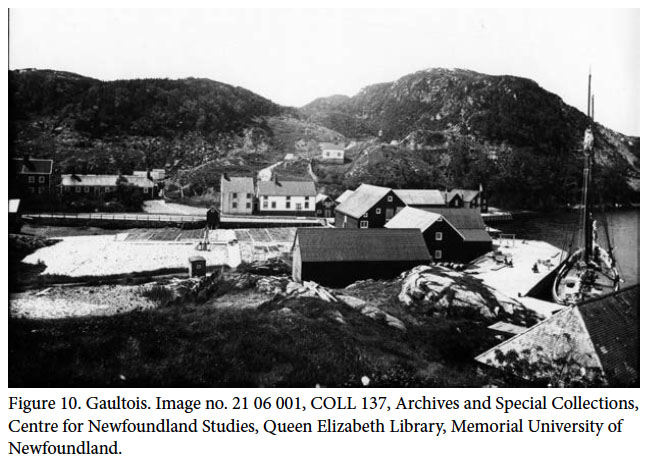 Display large image of Figure 10
Display large image of Figure 1085 In 1930, while in Belleoram, Karpeles met a Dr. Parsons, who offered to take her to Gaultois, as the community was accessible only by boat. On 22 July 1930, she commented:
Although Karpeles stayed just one night, she still managed to notate four songs by hand. Mrs. Elizabeth Cox provided her with “Fair Margaret and Sweet William” (Roud 253); Karpeles later published it in Folksongs from Newfoundland as variant B with one stanza and the tune (1970: 49). From Mrs. Wilson Northcott she obtained the cumulative song “The Tree in the Wood” (Roud 129), which she published twice (Karpeles, 1934, I: 72–73; 1970: 249–50). She also collected a B version of “The Gypsy Laddie,” consisting of one stanza and music that she published in the later edition (1970: 82–83). Perusal of her tune transcription books indicates that Mrs. Northcott also provided her with a version of “Father in Ambush” (Lovely Jimmy) (Roud 1913) (1970: 210–11). This is one of several unpublished songs in her collection.53
86 The census data for 1921 and 1935, coupled with details supplied by Gaultois resident Lloyd Lily, also helped me to establish the relationships among the people she met in the community.54 Mrs. Caroline Garland (b. 1870) was the wife of Thomas Garland (b. 1850); they had one adopted son. Elizabeth Cox (actually Cock) (b. 1858) was originally an Organ from Harbour Galley (Le Gallais) [Harbour Gallett] on Long Island. Her husband Samuel (b. 1857) was a fisherman native to nearby Burgeo. Mary Crant (1873–1935) of Gaultois was the mother of George Crant. Mrs. James Coombs, also from Gaultois, was originally Emma Matchem (1904–c. 1980); she married James Philip Coombs (b. 1903) from nearby Piccaire.
87 While in Gaultois, Karpeles also took a number of photographs close to a large building today identified as Thomas Garland Limited and known locally as the Big Fish Store. As she did not identify the individuals, Gaultois resident Lloyd Lilly provided clarification for two of these images.55 The photograph of the lady standing in front of the salt cod flakes was identified as Rebecca McDonald b. 1869) of Little Bay; she was the wife of David McDonald (b. 1869) (Figure 11). The white two-storey house in the far left background was Caroline Garland’s family home, where Karpeles stayed overnight.
 Display large image of Figure 11
Display large image of Figure 11
88 Evelyn Strickland Hunt (age 90) advised Lloyd Lilly that the man second from left in the second photograph (Figure 12) was her father, Albert Strickland Sr. (b. 1883), also from Little Bay. Both Mrs. Hunt and Mrs. Phyllis Harris of Gaultois noted as well that the tall man holding the wheelbarrow was Caroline Garland’s husband Thomas.
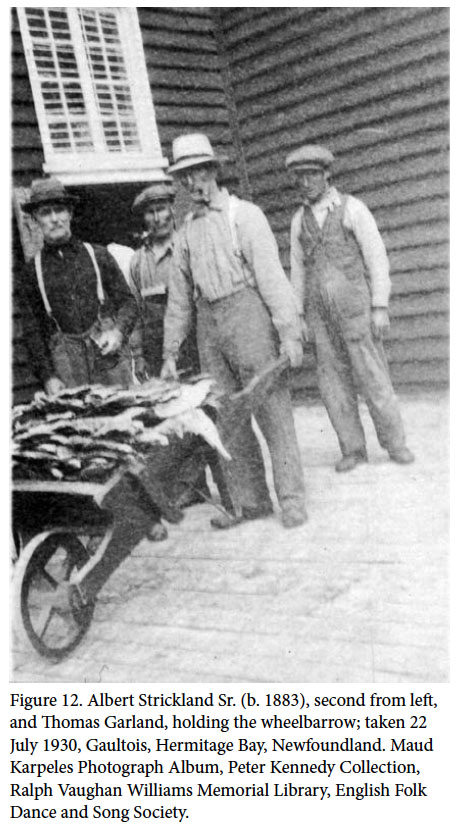 Display large image of Figure 12
Display large image of Figure 1289 Details such as these shed light on the activities she witnessed during her stopovers in various communities. For example, the Garland building occupies a prominent location in the community because of its association with the fisheries. Now designated as a heritage structure, it dates to the 1830s and was originally owned by the merchant firm of Newman and Company, Devon, England. This company maintained several fish-trading depots along the south coast, including at Gaultois. As a consequence of Newman and Company’s whaling and subsequent fish-trading activities in Newfoundland (MacDonald, 1989: 142–56), several families on the south coast, including those in Gaultois, trace their roots to Devonshire and Jersey (Handcock, 1989: 154; Miller Pitt, 1984: 489–91).
90 Although Karpeles makes no comment about taking the photographs while in Gaultois, these images today offer a valuable record of the concentrated activity associated with the cod fishery at Gaultois, which she casually documented in passing. By1930, Thomas Garland of nearby Pushthrough had taken over the Newman premises. The company was engaged in buying cod locally and making salt cod on its premises. Residents involved with the company were paid an hourly wage for work.56 The smell of cod and the annoyance of flies were intense.
91 When combined with her photography, Karpeles’s diary comments now provide us with a greater appreciation for the challenges she faced as a single woman travelling on her own. In July 1930, while making her way to Rencontre she remarked:
Frequently, she was dependent on an available bed wherever she could find one. On board the steamer heading for St. Mary’s Bay she remarked:
A poor day. Cold, wet & inclined to be foggy. Spent most of time lying down in my cabin. Wrote up my songs & a few letters but a good deal of motion & I don’t feel v[ery] happy. Steward came to my cabin to point out the Bird Rock to me — certainly a wonderful sight. A big high rocky cliff white with gulls.58 Got to St. Joseph’s ab[ou]t. 11 & decided to get off there as it seemed doubtful whether we sh[ou]ld call at St. Mary’s & I know nowhere to go there. So perked up in great haste. V[ery] high tide so I had to descend by means of ladder against side of steamer. A lady escorted me to Mrs. Cormack’s where I found a night’s lodging. A roomy house, I slept in spite of only ___ [?] blankets for a covering.59
92 As she commented years later, “Owing to the shortness of my sojourn and the difficulties of travel, my itinerary needed careful planning and it was often difficult to decide whether to take advantage of a passing steamer before the settlement had been fully explored, or to risk being stranded empty-handed for days” (Karpeles, 1970: 15).
Grole, South Coast — 23–24 July 1930
93 Between 23 and 24 July 1930, Karpeles spent approximately 24 hours in the community of Grole and commented, “Mr. B[urton] quite thrilled at my visit & w[o]rk I am doing, & busied himself getting singers to come to the house.”60 Karpeles also took several photographs of the singers she encountered. Former Grole residents Ernest Taylor, Harvey Jackman, and Jesse Fudge helped me piece together the links between the individuals in these images and, subsequently, the context for this one collecting expedition.61
94 As the Burtons and Jackmans of Grole were related, once again Karpeles tapped into a family network. Harvey Jackman notes that Henry Burton (1885–1962) (Figure 13a) was a man of “exceptional talents.” A fisherman and gifted carpenter, he built several churches, houses, and breakwaters on the south coast. In 1909 he married Agnes Jackman, a teacher and the daughter of Thomas Jackman and Suzanna Cribb Jackman. Agnes Burton Taylor (1922– 1988) was an adopted niece who lived with them (Figure 13a).
95 As Burton’s wife and family also were very musical, Burton arranged for his wife’s sister Florrie, her brother Joseph Cribb Jackman (1893–1974) (Figure 13b), and his son Theodore (1918–1984) (Figure 14a) to sing songs for Karpeles at their house. This information offers a new context for Karpeles’s comment, “This is certainly collecting made easy. Where the singers brought to one’s door, an organ on wh[ich] to play over the tunes after they have been noted.”62
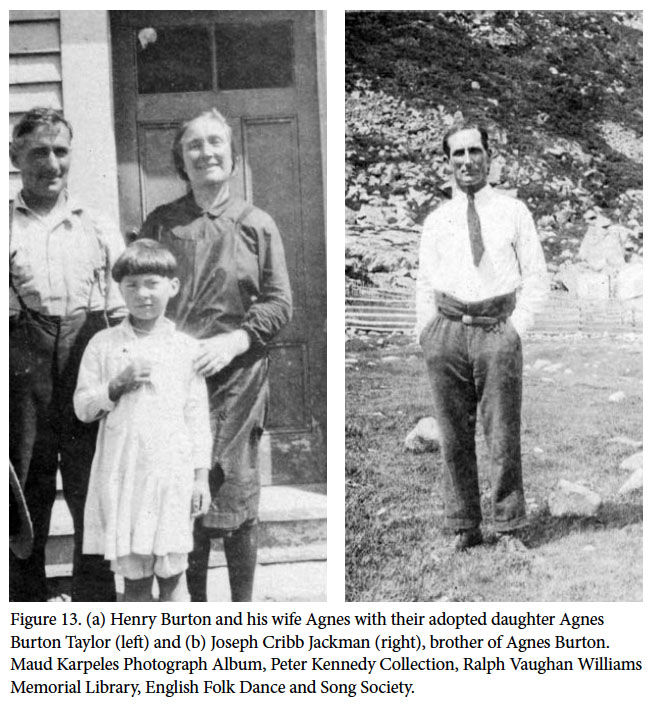 Display large image of Figure 13
Display large image of Figure 1396 Harvey Jackman also enlightened me on his father’s musical abilities, saying: “I have always considered my father a master of the button accordion; as well, he had that ability to sing along as he played. A talent not attributed to many accordion players. . . . Although they were Anglican, [they] played Salvation Army tunes. Sankeys, and dance tunes. . . . His middle name was Cribb, after the maiden name of his grandmother Sarah Jane Cribb, from England. . . . He had a melodious voice and I’m sure that anyone from Grole living today would easily recall his singing in church.”63 Several years later Joseph Jackman was one of several singers in Grole to be recorded by Jesse and Emily Fudge, who later published another of his songs, “Lather and Shave” (Roud 571), in It’s Time for Another One (1998: 46).64 Prior to leaving, Karpeles took a group shot of several of the community members down by the harbour-front store. She remarked, “Wandered round & talked to people & sang songs to a crowd that collected round me outside the store & took their photographs. Got a few more songs & then after dinner made my departure. V[ery] sorry to leave & I think the population of Grole is sorry to have me go.”65 The community of Grole was eventually resettled in the 1960s, so this image (Figure 15) is of considerable historical interest.
 Display large image of Figure 14
Display large image of Figure 14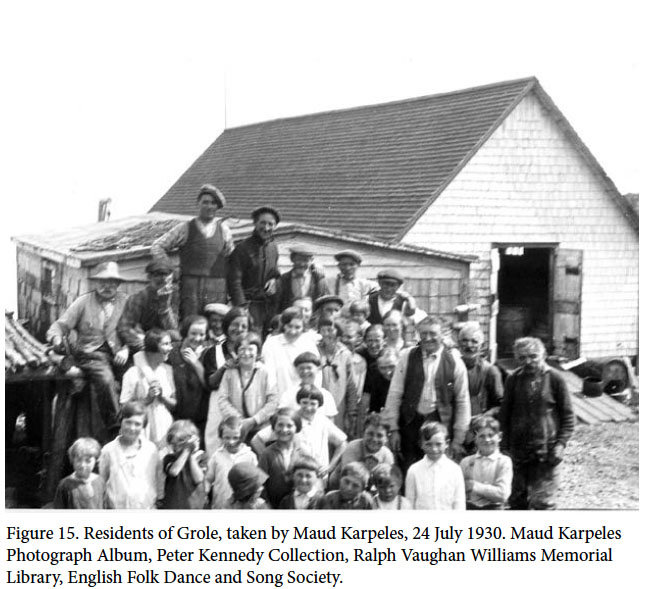 Display large image of Figure 15
Display large image of Figure 15REFOCUSING OUR OWN LENSES
97 Considering the arduous nature of travel in Newfoundland at this time, marked by such disruptions as irregular ferry and train schedules, Karpeles collected a remarkable amount of material during her field explorations. This is not always evident in her diary comments. While in Marystown she noted:
98 As her field notebook and music notebooks illustrate, Karpeles actually acquired four songs from Mary Joseph Mitchell. Three of these appear in Folksongs from Newfoundland: “The Dowie Dens of Yarrow” (Roud 13), “The Gypsy Laddie” (Roud 1), and “Lamkin” (Roud 6) (1970: 95, 83, and 72). She also collected but did not publish “The Cruel Mother,” a version of Child ballad No. 20 (Roud 9).67 Throughout her travels Karpeles acquired no less than 11 versions of this song about infanticide.68 She eventually published one composite example in 1934 (Karpeles, 1934, I: 8; 1934a: 5) and seven versions in Folksongs from Newfoundland (Karpeles, 1970: 32–38).
99 It has been argued that Karpeles’s narrow song paradigm did not do justice to the island’s extensive song tradition (Posen, 2012: 136). Looked at in a different light we are fortunate that she concentrated on particular song types. As her impressive cache of “Cruel Mother” examples illustrates, the song — also known as “Fair Flowers of Helio,” “Greenwood Siding,” and “The Babes in the Greenwood” — was prevalent with singers at this period and it was widely distributed. In contrast, Greenleaf and Mansfield (1933: 15–16) and Peacock (1965, III: 805–06) each acquired just two examples.69
100 Harmonizing Karpeles’s diaries with other field material, such as her tune transcription books and field notebooks, helps to remove assumptions about what she “said” she collected, what she “actually” collected, and what she eventually published. As all of this suggests, instead of focusing on what Karpeles did not collect, we should adjust our own lenses and refocus on the songs and dances she did acquire, in conjunction with the family and community networks that provided this material.
101 Karpeles possessed an extensive knowledge of English folksong and folk dance because of her involvement with the English Folk Dance and Song Society and through her extensive work with Cecil Sharp in the Appalachians. Despite her perception that the kinds of folksongs she sought were “going fast out of fashion” (Karpeles, 1970: 17), while in Newfoundland she recorded a living tradition embodying songs of British origin, but adapted to the local environment.
102 New inquiries about some of the singers visited by Karpeles, particularly on the south coast, reveal that several traced their lineage to the West Country of England. Ernest Taylor notes for example, that his grand uncle, George Taylor (Figure 16), from whom Karpeles collected the songs “Little Musgrave” (“Matthy Groves”) (Roud 52) and “Discharged Drummer” (Roud 2303) (Karpeles, 1970: 60–62, 229), had roots in Chiselborough, Somerset, England.
103 As Gregory (2004: 63) points out, “[her] collecting in 1930 on the southern coast of Newfoundland reveals not only an English musical heritage but a particular link with the West Country, and even, in a few instances, a specific connection with Dorset . . . a common culture with Victorian England.” Other researchers have made similar connections (McDonald, 1999; Tucker, 2010). Despite such observations, little formal work has been done to map out the specific nature of the transference of English folksong material to the province by way of oral traditions linked to historical and geographical connections, work and settlement patterns, or even through the availability of print material.70
104 In this sense the cluster of 56 songs Karpeles acquired from the south coast and Burin area could potentially help us to explore the dissemination of songs from certain locales in England to this part of the New World. Many of the first settlers in this region were brought to Newfoundland to serve as the labour force for merchant firms such as Newman and Company and Joseph Bird of Sturminster Newton, who also moved settlers to the Gros Morne region, the Labrador coast, and the Twillingate area (Chang, 1975; Handcock, 1977: 15–48; Mannion, 1977: 234–75; Kearney [Guigné], 1979: 65). This thread warrants at least some future investigation.
105 We should also applaud Karpeles’s pioneering explorations, especially on Newfoundland’s south coast, because of the time frame during which the research was carried out. As folksong research did not recommence in this region until the 1960s, Karpeles’s work in communities such as Grole, Hermitage, and Rencontre provides an important baseline, particularly in light of the recent images and newly acquired data on singers.71
A WOMAN ADVENTURER: MAUD KARPELES (1885–1976)
106 Maud Karpeles (Figure 17) has been depicted as a colonialist collector, driven to find and “repossess” English folksongs. I prefer to view her instead as a woman adventurer who successfully faced many challenges while on her quest for Newfoundland folksongs. Norm Cazden poignantly observed (1971: 165–67) that she achieved her lore the hard way and by longhand.
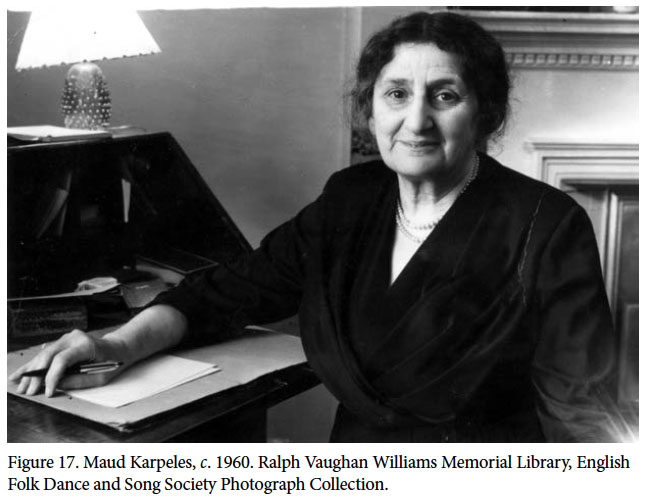 Display large image of Figure 17
Display large image of Figure 17
107 As Karpeles quickly learned, travel in England’s oldest colony was complicated and the living conditions were harsh. She made her way by foot, ferry, open boat, car, and train, often being set down in strange places late at night. Having spent 46 weeks in the Appalachians, where the living conditions and heat were equally challenging, undoubtedly she could speak from experience regarding flies, food, and sanitary conditions. And yet, she seems to have been a good sport — singing to crowds, playing cards, and visiting constantly and at length with strangers. As the following three examples illustrate, her energy and flexibility come out in the diaries:
- Mr. P. rowed me back & after tea I went with him to the Randalls & was introduced to “45” the N’fld card game.
- News of my coming had spread around & there must have been 40 people or more in the room. I got only one song, the rest no good. I sang a lot to them and altogether we spent a delightful evening.
- People are very reserved at first. But they soon warm up. I entertained a little crowd of men on the road singing them “Edward.” Saw Sam Moss at Open Hall & got a beautiful tune [“Nancy of London” (Roud 407)] from him wh[ich] took me a long time to get, but he (as all of them) was wonderfully patient.72
She evidently made friends with several singers and, in one documented case, had sent a card of remembrance to singer Teresa Corbett of Conception Harbour.73
108 This new examination of Karpeles’s 1929 and 1930 Newfoundland field research, instigated by the discovery of an album of photographs she had taken during this period, continues to be a work in progress. Tasks such as accounting for all the material she acquired, transcribing the diaries and relating this material to other field data such as her music notebooks, and identifying the people she interviewed and interviewing family members have provided fruitful results, bringing a new order to her collection so diligently created over 80 years ago. In this sense, each singer and each community has something distinctive to offer. Community involvement, which continues to be an essential part of this project, now enables Karpeles’s research and the material she collected to take on new relevance, highlighting for those in the present the value of their local family and community heritage, as well as the documentation of musical traditions in communities that have since resettled. This process of reclamation, instigated by the photographs, also means that we can finally move beyond her diaries and letters, thereby shifting the emphasis to the singers and communities she visited 80 years ago.
